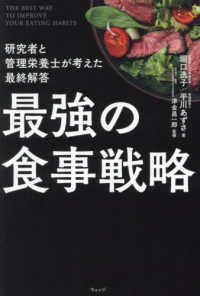- ホーム
- > 洋書
- > ドイツ書
- > Humanities, Arts & Music
- > History
- > 20th century (1914-1955/49)
Full Description
In einem Europa großer ethnischer, sprachlicher, religiöser und kultureller Vielfalt vollzieht sich etwa zwischen 1450 und 1650 der Prozess der Nationenbildung, in dem sich neben dem Heiligen Römischen Reich Deutscher Nation die jungen Nationalstaaten Europas entwickeln und die kulturellen Eliten ihrer Zeit dadurch ihre soziale Identität zu finden suchen. Dazu dient zum einen die produktive Erinnerung an die eigene Geschichte, dann aber auch die in vielfältigen Erscheinungsformen erkennbare 'Konstruktion der Gegenwart und Zukunft'. Diese kann durch die Herausbildung neuer, zeitbezogener Texte und Bilder im Kontext des Cultural Building of Nations geleistet werden, aber auch durch neue Institutionen z.B. der Wissenschaft und der staatlichen, regionalen oder stadtbürgerlichen Kultur. Die elf Studien des Tagungsbandes in deutscher und englischer Spache wollen zeigen, wie neue Sachtexte, Bilder und Einrichtungen die kulturelle Identität der Gesellschaft auf verschiedenen Ebenen zu stiften vermögen.
Between 1450 and 1650, a process of nation building took place in an ethnically, linguistically, religiously and culturally diversified Europe. Next to the Holy Roman Empire, young European nation states came into being whose cultural elites strove to establish their social identity not only through productive reflection on their own pasts, but also by means recognizable constructions of the present and the future. This cultural building of nations took place through new texts and images, as well as by new institutions of science, administration, and civic culture. The eleven studies in this volume of proceedings examine how texts, images and institutions contribute to the construction of a society's cultural identity.
Contents
Aus dem Inhalt/Contents: Gabriela Signori: Beat, der Schweizerapostel. Eine hagiographische 'Invention of Tradition' - Ulrike Graßnick: And out of olde bokes, in good feyth, Cometh al this newe science that men lere. Mirrors for Princes, Literary Strategies, and the Set of Values and Norms in Late Medieval England - Thomas Althaus: Das Reichskammergericht zu Speyer und der Sprichwörter-Thesaurus des Christoph Lehmann - Gunhild Roth: Von der Reformidee zur Institution: Der schwierige Weg der Constitutio Criminalis Carolina - Richard Fawcett: Gothic or Classical? The Continuity of Medieval Forms in Scottish Church Architecture - John North: Merton College: Advanced Learning by Accident and Design - Arjan van Dixhoorn: New Institutions and the Dynamics of Civic Culture: Chambers of Rhetoric in the Early Modern (Northern) Netherlands - Robert Stein: The State's Officers: The Burgundian Netherlands in the Middle of the Fifteenth Century - Serge ter Braake: In the Service of Sovereign and Subjects: Conflicting Loyalties of Holland Officials at the End of the Middle Ages (1480-1550) - Michael Lynch: The Emergence of a Capital City: Edinburgh, 1450-1603 - Peter Wolf: Literarische Spaziergänge. Stadttopographie und Chronistik am Beispiel Regensburgs um 1600.








